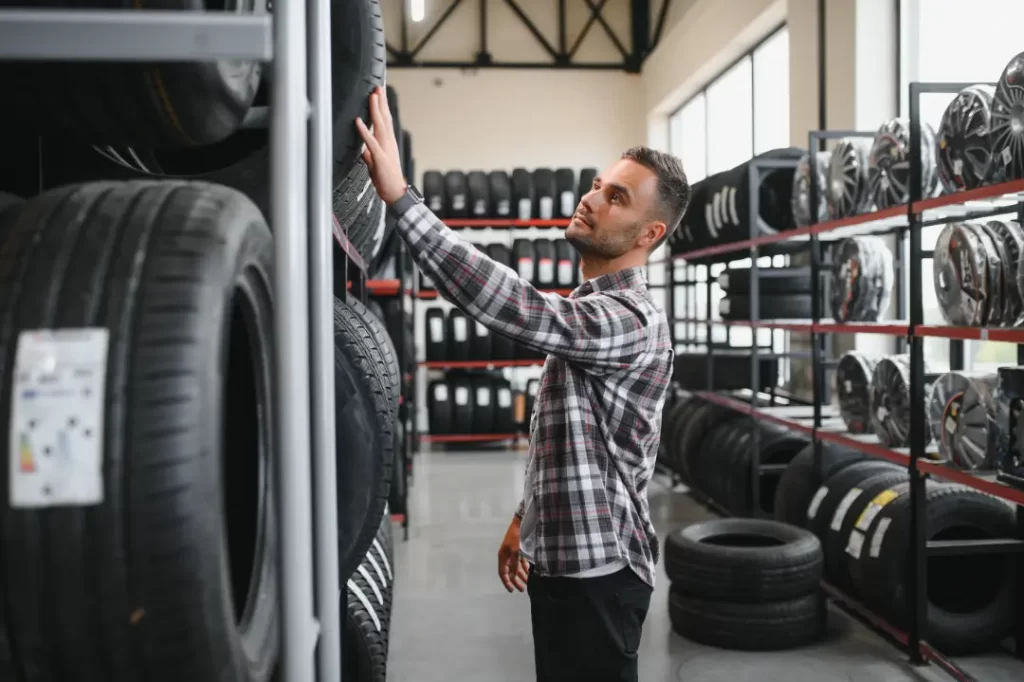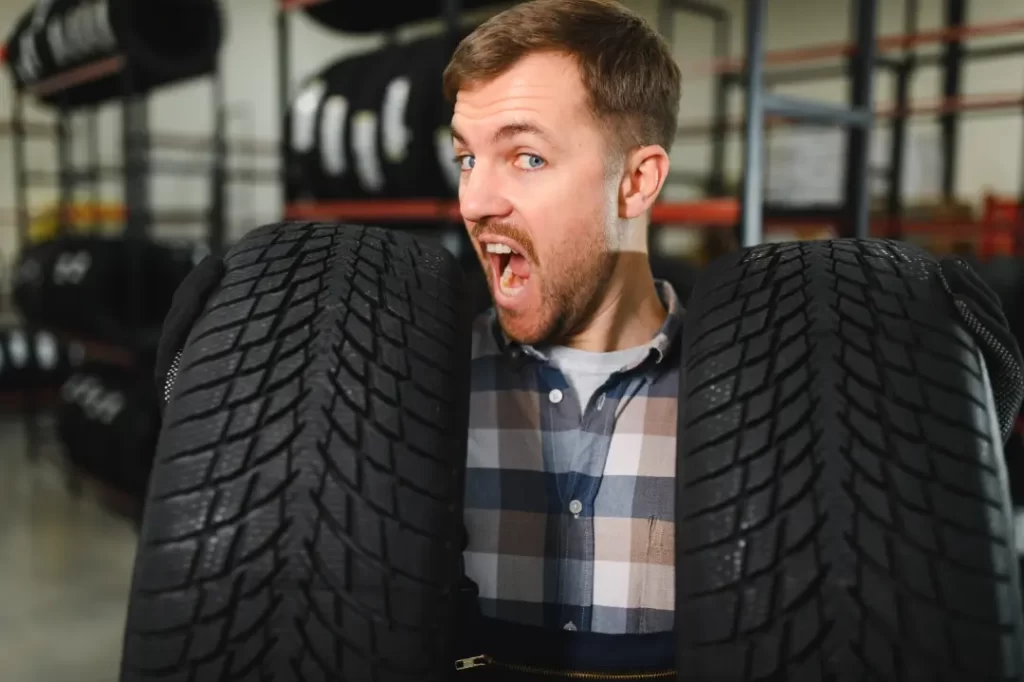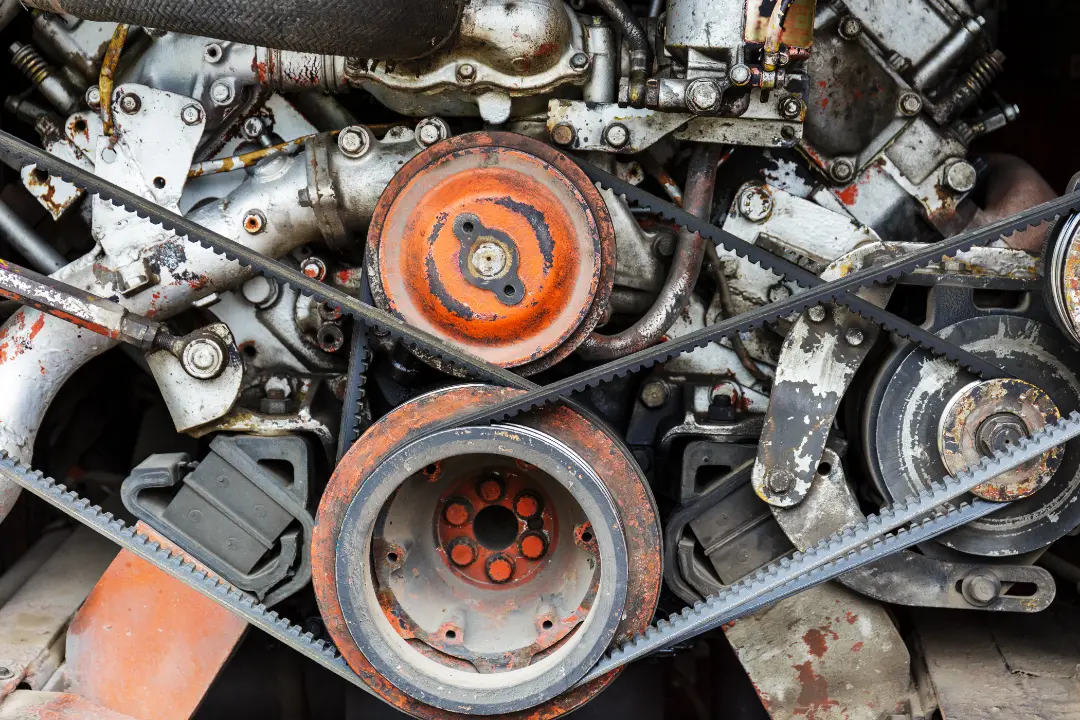Understanding tyre types is crucial for your vehicle’s safety and performance. In this guide on tyre types, we’ll explain the different types of tyres and what each type is for. From summer tyres to winter tyres, you will learn what each type is best for, so you can choose wisely.
Key Takeaways
- There are various tyre types designed for specific driving conditions, including summer, winter, all season, and more, each impacting vehicle performance and safety.
- Understanding tyre specifications, including tread patterns and size markings, is crucial for selecting the right tyres to ensure optimal handling, traction, and vehicle safety.
- All-season tyres blend summer and winter features for year-round reliability. They handle moderately well in both hot and cold conditions.
- The right tyre type boosts performance and safety in its intended season. Using the wrong tyre can shorten lifespan and reduce grip.
- Choosing tyres should match your driving conditions and climate. A professional fitting ensures maximum safety and efficiency.
- Proper tyre maintenance, such as checking pressure, inspecting for damage, and regular rotation is essential for extending tyre life and maintaining vehicle safety.
What Are the Different Tyre Types?
When it comes to tyres, one size does not fit all. The automotive industry offers a variety of tyres to meet the diverse needs of drivers and their vehicles. The most common tyre types include:
- Summer tyres
- Winter tyres
- All-season tyres
- Run flat tyres
- High-performance tyres
- Energy-efficient tyres
- 4×4 tyres
Each type is designed to meet specific requirements based on the weight and load of different vehicles.
Choosing the right tyres can significantly affect your vehicle’s performance. Generally, tyre impacts handling, safety, and fuel efficiency. For instance, summer tyres provide excellent grip and durability in warm weather, while winter tyres offer superior traction in snow and ice.
The right tyres can also enhance driving comfort, making your journeys smoother and more enjoyable.
Different tread designs are also essential for traction in varying weather conditions. For example, symmetrical tread patterns provide stable driving and low rolling resistance, while directional tread patterns enhance resistance to aquaplaning.
Understanding these specifications helps you select the perfect tyres for your vehicle, ensuring optimal performance and safety.

Summer Tyres
Summer tyres are designed for warm weather conditions, providing:
- Enhanced grip and durability on both wet and dry roads
- Specialist rubber compound that ensures good performance in wet weather
- Resistance to aquaplaning thanks to unique tread patterns
- Typically, the widest option available offering greater contact with the road surface.
However, summer tyres are not suitable for handling snow or ice, which can pose a significant safety risk during the winter months. Although they are commonly fitted to most passenger vehicles for year-round use, their performance drops significantly in colder conditions, making the choice between winter and summer tyres crucial.
Many drivers prefer summer tyres due to their superior grip and performance in warm weather. Their ability to provide a smooth, responsive driving experience makes them popular for those prioritising performance and handling during the hotter months.
Winter Tyres
Winter tyres are specifically designed for cold weather, including snow and ice. They offer greater traction in these conditions, making driving in snow, ice, and rain much easier and safer. Features such as large grooves and sipes enhance the traction of winter tyres, helping maintain grip on icy roads.
One of the key components of winter tyres is their higher natural rubber content, which helps them remain flexible even in low temperatures.
This flexibility, aided by a softer rubber compound, is crucial for maintaining traction and control when temperatures drop, especially in cold weather conditions.
Using summer tyres during the winter season can significantly increase stopping distances and pose safety risks.
While all season tyres provide adequate performance throughout the year, they do not match the specialized capabilities of winter tyres in extreme conditions. Winter tyres wear out quickly when used in warm weather, so it’s essential to switch back to summer or all season tyres as temperatures rise.
All Season Tyres
All season tyres combine features of both summer and winter tyres, making them suitable for year-round use. They balance performance between the two seasons, providing a safe driving experience without the need for seasonal changes. However, they do not outperform dedicated seasonal tyres in extreme conditions.
These tyres are built with advanced features that keep you safe and comfortable in different driving conditions. Special tread blocks channel water away quickly, lowering the risk of hydroplaning on wet roads. High-density siping improves grip in cold weather, giving you better handling and braking when surfaces turn icy.
Furthermore, some all-season designs reduce road noise and maintain steady contact across changing surfaces, so your ride stays smooth and reliable year-round.
While all-season tyres are a convenient option for many drivers, they are best suited for areas with mild climates where extreme weather conditions are rare. They offer a versatile solution for those who prefer not to switch between summer and winter tyres.
If you’re considering all-season tyres for year-round use, AVS Sittingbourne stocks a wide range of authentic options and offers quick fitting both in-garage and through our mobile service for maximum convenience.
Run Flat Tyres
Run flat tyres are designed to maintain safety and control after a puncture by allowing the driver to continue driving for a limited distance. This is achieved through reinforced sidewalls that enable the tyres to support the vehicle’s weight even when air pressure is lost.
Drivers can continue to drive on run-flat tyres for approximately 50 miles after experiencing a puncture, providing peace of mind and eliminating the immediate need for a roadside tyre change. However, it’s important to note that run-flat tyres cannot be repaired after a puncture and must be replaced with a new tyre to ensure safety.
Run flat tyres are designed to keep you moving after a puncture.
High Performance Tyres
Some tyres are built for sharper handling and enhanced grip and are often used on performance vehicles. We can advise you on options if you’re after a tyre with a more responsive road feel. These tyres provide superior grip, handling, and responsiveness, enhancing the driving experience for those who enjoy pushing their vehicles to the limit.
High-performance tyres tend to have more rubber in contact with the road, which enhances traction and improves cornering capabilities. However, they do not last as long as standard tyres and wear down more quickly, making replacements more frequent and sometimes challenging to find.
In wet conditions, high-performance tyres can be harder to control due to shallower grooves, which may impact their ability to displace water effectively on wet roads. Despite these trade-offs, they are a preferred choice for drivers seeking maximum vehicle performance and responsiveness from their vehicles, as they provide more grip.
Energy Efficient Tyres
Energy-saving tyres are specifically designed to minimize the energy needed for vehicle movement, characterized by low rolling resistance that improves fuel economy and reduces CO2 emissions while also offering reduced rolling resistance. These tyres can significantly decrease fuel consumption, leading to substantial cost savings for drivers.
Some tyres typically last longer than standard tyres, reducing the frequency of replacements and contributing to lower carbon emissions due to reduced fuel usage. Tread patterns play a crucial role in this efficiency by reducing rolling resistance while maintaining traction and handling.
Choosing premium tyres can lead to better fuel economy due to advanced technology aimed at reducing rolling resistance. These fuel efficient tyres are an excellent choice for drivers looking to reduce their environmental impact and save on fuel costs.
4×4 Tyres
4×4 tyres are designed for off-road driving and sporty on-road performance, engineered for the unique demands of vehicles that distribute power to all four wheels. The tread patterns on 4×4 tyres are wider and designed to prevent mud and debris from clogging, ensuring better traction.
These tyres are:
- Tested for safety and performance, ensuring a comfortable driving experience on steep inclines and soft ground.
- Constructed to accommodate heavier loads compared to standard tyres.
- Featuring reinforced sidewalls for added durability and load-bearing strength.
4×4 tyres provide better traction on muddy terrain compared to standard tyres, making them an excellent choice for adventurous drivers seeking reliability and performance in challenging conditions.
Van Tyres
Van tyres are designed to provide increased grip and longevity, which is essential for vehicles carrying heavy tools and passengers. These tyres are built to support heavy loads, featuring reinforced sidewalls and durable construction to endure the unique stresses of commercial use.
Different van models require distinct tyre specifications based on their weight and usage characteristics, such as the Michelin Agilis range tailored for commercial vehicle operators. Van tyres differ significantly from standard car tyres, ensuring safety and performance for commercial vehicles.
Understanding Tyre Size
Tyre size markings are a combination of numbers and letters representing dimensions and performance characteristics, essential for selecting the appropriate tyres for your vehicle. Key factors indicated by tyre size markings include:
- Width
- Aspect ratio
- Diameter
- Load index
- Speed rating.
The width of a tyre is measured in millimetres from sidewall to sidewall, while:
- The aspect ratio reflects the height of the tyre’s sidewall height as a percentage of its width.
- The rim diameter indicates the size of the wheel the tyre will fit.
- The load index shows the maximum weight each tyre can support, considering the sidewall height.
It is essential to understand tyre sizes when selecting tyres. This knowledge ensures safety and performance for your vehicle. Using the correct tyre size is vital for vehicle safety, performance, and insurance validity.
Tread Patterns and Their Importance
Different tread patterns are designed to meet specific driving needs, impacting overall tyre performance. Symmetrical tread patterns provide stable driving and low rolling resistance and are ideal for tyre rotation without affecting performance.
Directional tread patterns are designed for one-way rotation, enhancing resistance to aquaplaning and providing excellent traction in snow and mud.
Asymmetric tread patterns combine two distinct designs, improving water displacement and cornering grip on dry surfaces.
Tread patterns are a crucial aspect of tyre design, influencing traction, handling, tread depth, and overall vehicle performance in the tread area. Understanding these tyre patterns and tread designs can help you choose the right tyres for your driving needs, ensuring safety and efficiency on the road.
Are Part Worn Tyres Reliable?
Part-worn tyres are second-hand tyres that still have some usable tread, but they come with significant risks:
- They may have highly dangerous forms of damage that are not visible during inspection.
- Many part-worn tyres sold may have serious hidden issues.
- These hidden issues make them potentially unsafe.
Moreover, tyres that have been poorly repaired can fail suddenly, especially if the damage is near the tyre sidewall, affecting insurance coverage and safety. It is crucial to be cautious when considering part-worn tyres, as their hidden issues can pose significant dangers on the road.

Budget vs Premium Tyres: Which is Better?
When considering budget and premium tyres, it’s essential to weigh the key areas of:
- Cost
- Performance
- Durability
- Safety.
Budget tyres are designed to offer basic safety and comfort for general usage, making them suitable for short, urban journeys. However, they typically have a shorter lifespan due to the materials used in their construction.
On the other hand, premium tyres offer:
- Enhanced grip, traction, and handling, which lead to a superior driving experience, especially on long-distance journeys.
- Manufacturing with higher-quality materials boosts their durability and extends their lifespan.
- Availability with a warranty to guarantee quality and durability.
Ultimately, the choice between budget and premium tyres should be guided by your driving needs and budget.
Premium tyres are ideal for those who prioritise high performance and long-lasting durability, whereas budget tyres are a cost-effective solution for everyday driving.
Tyre Maintenance Tips
Proper tyre maintenance is crucial for extending the life of your tyres and ensuring safety on the road. One of the most important aspects of tyre maintenance is regularly checking tyre pressure.
Using a reliable gauge to check pressures ensures accurate readings, and it’s recommended to check pressures when tyres are cold, ideally after driving less than two miles.
Under-inflated tyres can lead to increased fuel consumption and reduced vehicle performance. Additionally, it’s essential to inspect tyres for cuts or damage that could lead to blowouts. Uneven tread wear can be caused by incorrect tyre pressure or wheel alignment, so regular inspections are necessary.
Rotating tyres every 6,000 miles helps distribute wear evenly, ensuring longer tyre life and consistent performance. Maintaining the correct tyre pressure, inspecting for damage, and rotating tyres regularly are key practices for keeping your tyres in optimal condition.
Regular tyre checks and maintenance are best left to professionals, and AVS in Sittingbourne is the trusted local garage where skilled technicians ensure your tyres are always safe, reliable, and road-ready.
AVS Sittingbourne: Your Local Experts for Tyre Fitting and Tyre Replacement
Choosing the right garage for your tyres isn’t just about getting rubber on your wheels but about safety, reliability, value, and peace of mind every time you drive.
At AVS Sittingbourne, our team has spent years building a reputation for trusted, high-quality service that puts our customers first in every situation. Whether you’re after premium tyres from leading brands or a dependable budget-friendly option, you’ll always get authentic products backed by professional fitting expertise.
We also understand that life doesn’t always give you the time to sit around a garage, which is why we proudly offer mobile tyre fitting right at your doorstep or workplace.
So, if you want the perfect combination of genuine tyres, expert fitting, and unmatched convenience, AVS is the name Sittingbourne drivers trust most.
- We supply and fit authentic, high-quality tyres from the world’s most trusted brands, ensuring your safety and performance are never compromised.
- Our mobile tyre fitting service brings our workshop to your home, office, or even roadside, so you never have to worry about being stranded.
- Every tyre is fitted by our experienced technicians who take the time to get the job done right, with precision and care.
- We offer a huge selection of tyres to suit every budget, vehicle type, and driving condition, from everyday cars to performance vehicles and vans.
- At AVS, we pride ourselves on clear, honest pricing with no hidden extras, so you always know exactly what you’re paying for.
- Our Sittingbourne garage is trusted locally because we deliver not just tyres, but also long-lasting value and genuine customer care.
- With same-day fitting available, you can count on us to help you with your tyres quickly, safely, and without hassle.
Choosing AVS means choosing convenience, expertise, and reliability that other garages simply can’t match.
Whether you need a quick replacement, seasonal tyres, or roadside fitting, our team has you covered from start to finish. Book your tyre fitting or tyre replacement with AVS Sittingbourne today.
How to Choose the Right Tyres for Your Vehicle
Selecting the right tyres for your vehicle involves considering several key factors, including vehicle size and weight, type of vehicle, driving style, and typical weather conditions.
Establishing a budget is crucial, as it helps balance cost with the safety and performance that quality tyres provide. Now, while premium tyres may offer better performance and longevity, budget tyres can be a cost-effective solution for less demanding driving conditions.
Ultimately, choosing the right tyres involves understanding your driving needs and the specific requirements of your vehicle. Considering factors such as vehicle type, driving conditions, and budget helps in selecting tyres that ensure safety, performance, and value for money.
Frequently Asked Questions
What are the main differences between summer tyres and winter tyres?
The main difference between summer and winter tyres lies in their design for different weather conditions. Summer tyres excel in warmth. They offer improved grip on both wet and dry surfaces. Winter tyres are optimised for cold climates. They provide superior traction on snow and ice. Prioritising the right tyre for the season is essential for safety and performance.
Can I use all-season tyres instead of switching between summer and winter tyres?
You can use all-season tyres year-round, as they combine features of both summer and winter tyres. However, in extreme conditions, they may not perform as well as dedicated seasonal tyres.
What are run-flat tyres, and how do they work?
Run flat tyres allow you to maintain control and safety after a puncture, enabling you to drive for about 50 miles thanks to their reinforced sidewalls that support the vehicle’s weight even without air pressure.
This design ensures you can reach a safe location without the immediate need for a tyre replacement.
Are budget tyres safe for long-distance driving?
Budget tyres may suffice for short distances, but for long-distance driving, premium tyres are recommended due to their superior grip, traction, and durability, ensuring a safer experience.
How often should I check my tyre pressure?
You should check your tyre pressure at least once a month using a reliable gauge to ensure optimal performance and safety. Always check when the tyres are cold for the most accurate readings.
Conclusion
Understanding the different types of tyres and their specific uses is essential for making informed decisions that enhance vehicle performance and safety.
From summer and winter tyres to high-performance and energy-efficient options, each tyre type offers unique benefits tailored to specific driving conditions and preferences.
By selecting the right tyres for your vehicle and maintaining them properly, you can ensure a safer, more efficient, and enjoyable driving experience. Investing in the right tyres not only enhances performance but also contributes to better fuel economy and overall vehicle longevity. Remember, the right tyres can make all the difference on the road.


